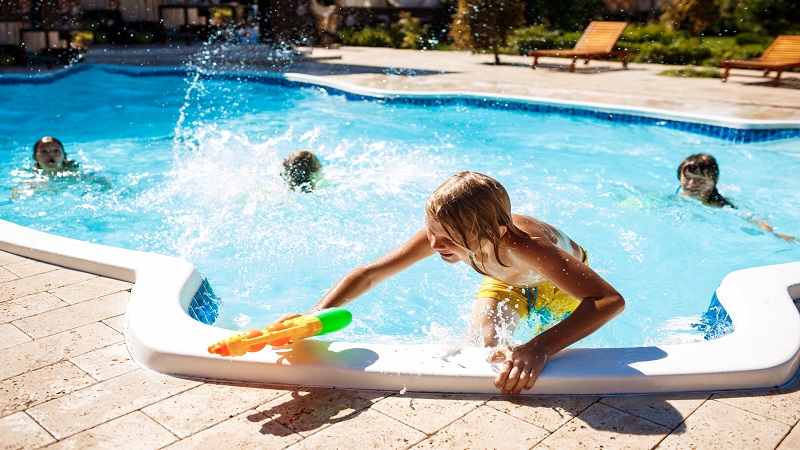Having a pool at home is a true luxury. It offers a space for relaxation, exercise, and social gatherings. However, the enjoyment of crystal-clear water depends heavily on how well the pool is maintained across changing seasons. Different times of the year bring unique challenges, whether it’s algae growth in summer or freezing temperatures in winter. Proper seasonal care ensures the pool remains safe, functional, and inviting throughout the year.
This guide provides a complete overview of how to prepare your pool for summer’s heat and winter’s chill, covering cleaning, chemical balancing, equipment care, and long-term maintenance strategies.
Why Seasonal Care Matters
Many pool owners mistakenly believe that occasional cleaning is enough to keep water in good condition. In reality, a pool needs tailored care during summer and winter because environmental conditions affect water quality and equipment differently.
- In summer, warm temperatures accelerate algae growth, increase evaporation, and encourage heavy usage. More swimmers mean more contaminants, requiring extra care.
- In winter, cold weather, frost, and debris accumulation can damage pool surfaces, plumbing, and pumps if not managed properly.
Seasonal preparation prevents costly repairs, keeps water safe, and extends the lifespan of the pool structure and accessories.
Preparing a Pool for Summer
Summer is the most active swimming season, so your focus should be on clean water, balanced chemicals, and safety.
1. Remove Covers and Inspect the Pool
If your pool has been covered during cooler months, start by carefully removing the cover. Clean and dry it before storing it for reuse. Inspect the pool for visible cracks, stains, or damaged tiles.
2. Refill and Circulate Water
During off-seasons, water levels may drop due to evaporation or intentional draining. Refill the pool to the proper level, usually halfway up the skimmer opening. Turn on the pump and filtration system to circulate water for at least 24 hours before swimming.
3. Clean Surfaces Thoroughly
Use a skimmer net to remove leaves, twigs, and insects. Brush the walls and floor to loosen dirt and algae. Vacuum the bottom to ensure a spotless swimming area.
4. Balance Pool Chemistry
Maintaining balanced water chemistry is vital during hot weather:
- pH level: Keep it between 7.2 and 7.6 for swimmer comfort.
- Chlorine: Maintain between 1–3 ppm to disinfect water effectively.
- Alkalinity: Aim for 80–120 ppm to stabilize ph.
- Calcium hardness: Prevents corrosion and staining; maintain 200–400 ppm.
Test the water with reliable kits at least twice a week in summer.
5. Shock the Water
Before opening your pool to regular use, shock it with a higher dose of chlorine. This kills bacteria and algae spores that may have developed during downtime.
6. Inspect Equipment
Check pumps, filters, heaters, and skimmers for leaks or malfunctions. Clean filters thoroughly. Replace any broken parts to avoid interruptions in the season.
7. Maintain Regular Cleaning
Once in use, clean the pool daily or at least three times a week. Encourage swimmers to shower before entering to minimize oils and lotions entering the water.
Preparing a Pool for Winter
Winterization is about protecting the pool from freezing temperatures, heavy rainfall, and debris accumulation. Even if you don’t use it in the cold months, neglecting care can lead to expensive repairs.
1. Deep Cleaning Before Closing
Thoroughly vacuum and scrub the pool before closing for winter. Remove all floating debris, brush walls, and ensure water clarity.
2. Adjust Water Chemistry
Balance water chemistry before shutting down:
- Lower chlorine slightly to prevent corrosion during storage.
- Raise alkalinity to around 100–120 ppm.
- Maintain pH at 7.4–7.6.
- Apply a specialized winterizing kit to stop algae growth while the pool is closed.
3. Lower Water Level
Drain the pool water to just below the skimmer opening or according to manufacturer instructions. This prevents freeze damage to plumbing.
4. Protect Equipment and Plumbing
- Drain water from pumps, filters, and heaters to prevent freezing inside pipes.
- Blow out pool lines with air compressors if you live in extremely cold areas.
- Add antifreeze to pipes where draining isn’t possible.
5. Cover the Pool Properly
A high-quality cover is essential. It keeps debris out, reduces evaporation, and prevents accidental falls. Ensure the cover is secured tightly and regularly remove accumulated snow or water from its surface.
6. Store Accessories
Remove ladders, floats, toys, and any detachable fittings. Store them in a dry, sheltered space to prevent weather damage.
Common Mistakes to Avoid
Even experienced pool owners make errors that compromise pool safety and durability. Here are common mistakes to watch out for:
- Skipping water testing: Neglecting chemistry balance allows bacteria and algae to thrive.
- Improper cover installation: Loose covers let in debris and can collapse under heavy snow.
- Leaving equipment full of water: Frozen pipes or pumps can crack and require costly replacement.
- Delaying maintenance until problems appear: Preventive care is far cheaper than emergency fixes.
Year-Round Maintenance Tips
While seasonal adjustments are crucial, some practices should continue all year:
- Regular inspections: Even in winter, check the pool area periodically.
- Equipment upkeep: Lubricate O-rings, clean filters, and replace worn gaskets.
- Safety measures: Ensure fences, alarms, and lighting are functional regardless of season.
- Professional servicing: Schedule annual inspections to catch hidden issues early.
The Benefits of Proper Seasonal Care
Investing time in seasonal care has long-term benefits:
- Cost savings: Prevents damage to pipes, pumps, and surfaces.
- Health protection: Reduces risk of bacteria and chemical imbalances.
- Aesthetic appeal: Keeps water sparkling and inviting.
- Extended pool life: Preserves structural integrity for decades.
When properly maintained, a pool becomes a lasting feature of your home, enhancing lifestyle and property value.
Conclusion
Seasonal care ensures your pool remains a source of enjoyment, not frustration. Preparing a pool for summer involves cleaning, balancing chemicals, and ensuring safety for frequent use. Winter preparation focuses on protection—covering, draining, and safeguarding equipment against freezing. By following these steps, you protect your investment, save on repair costs, and guarantee a safe swimming experience every year.
A pool is more than just water—it’s a responsibility. With the right seasonal care practices, you can enjoy refreshing swims in summer and rest easy during winter, knowing your pool is secure and well-maintained.

